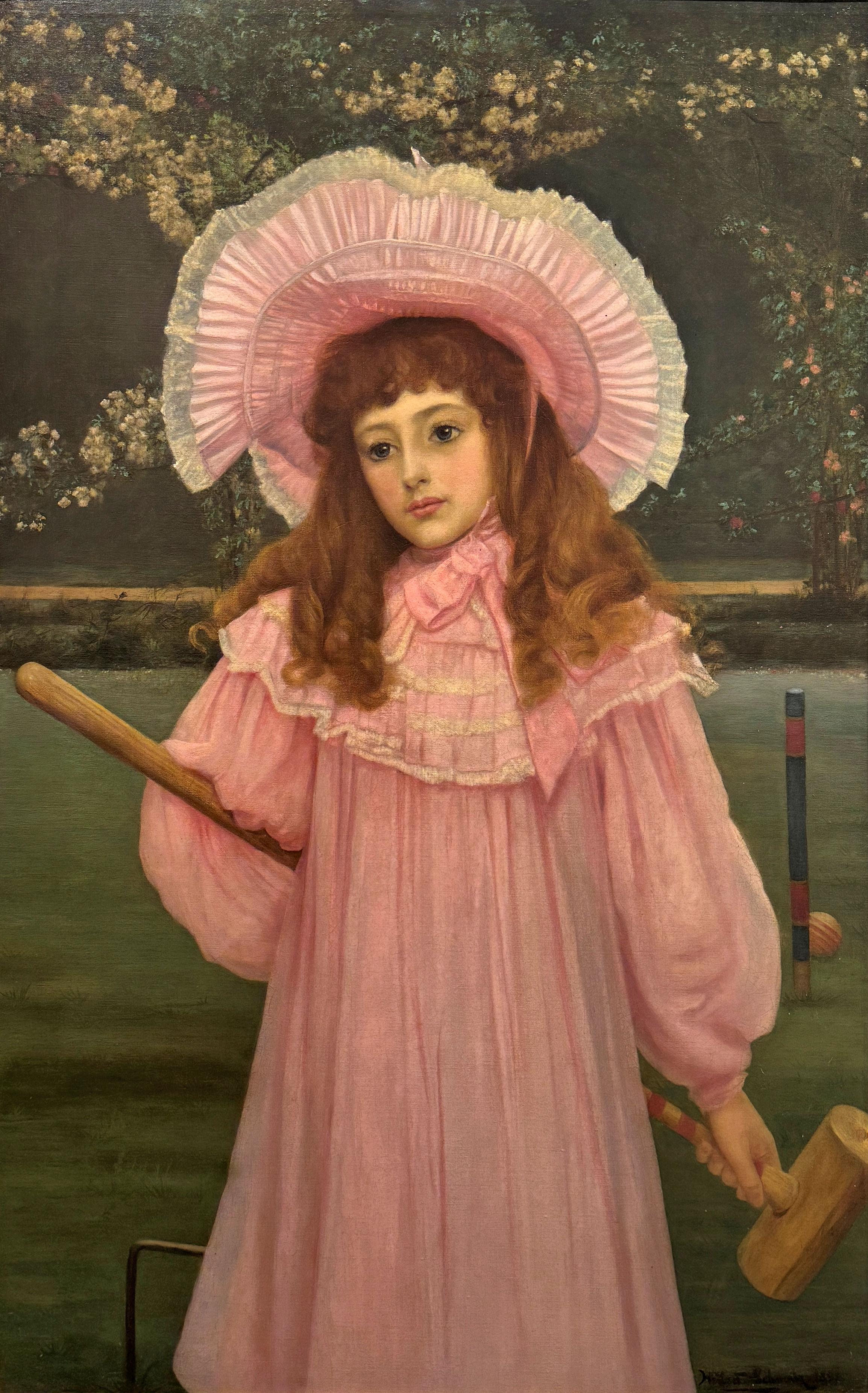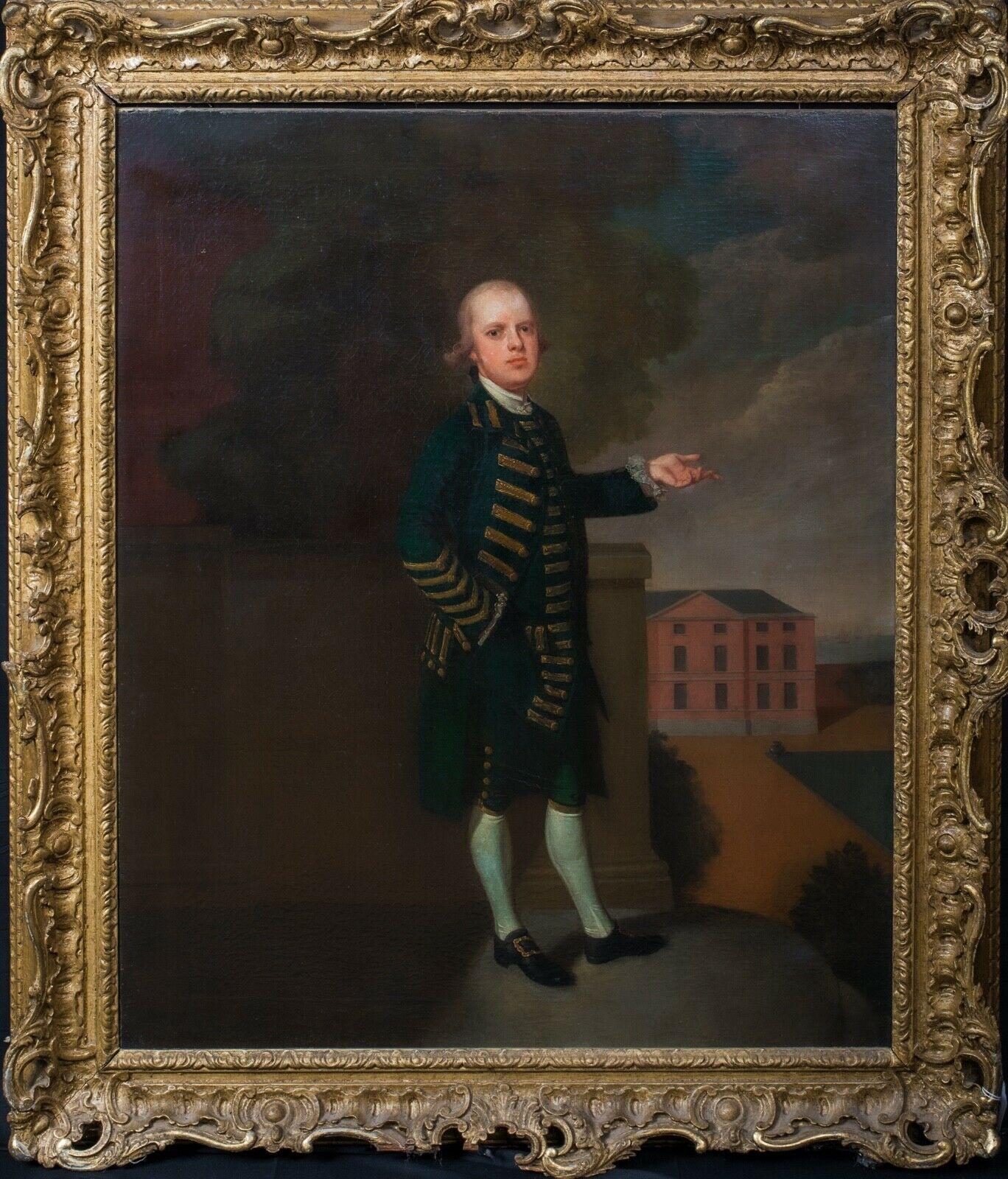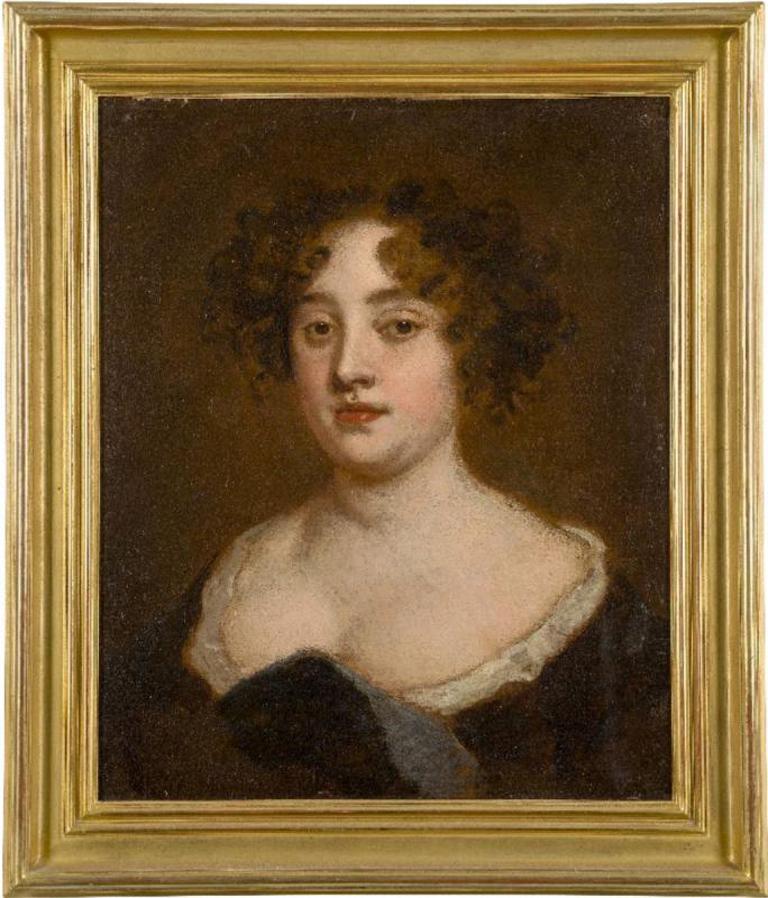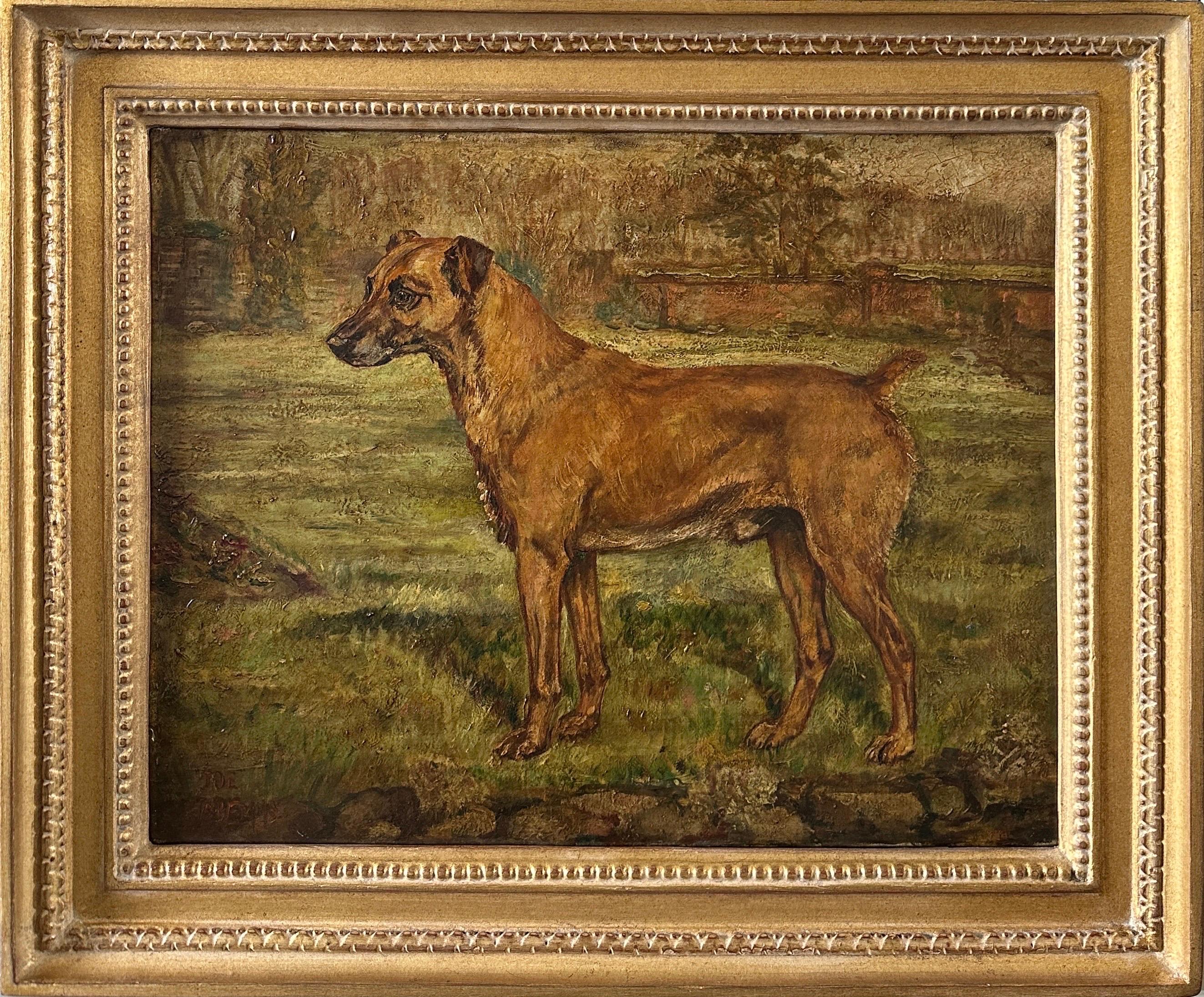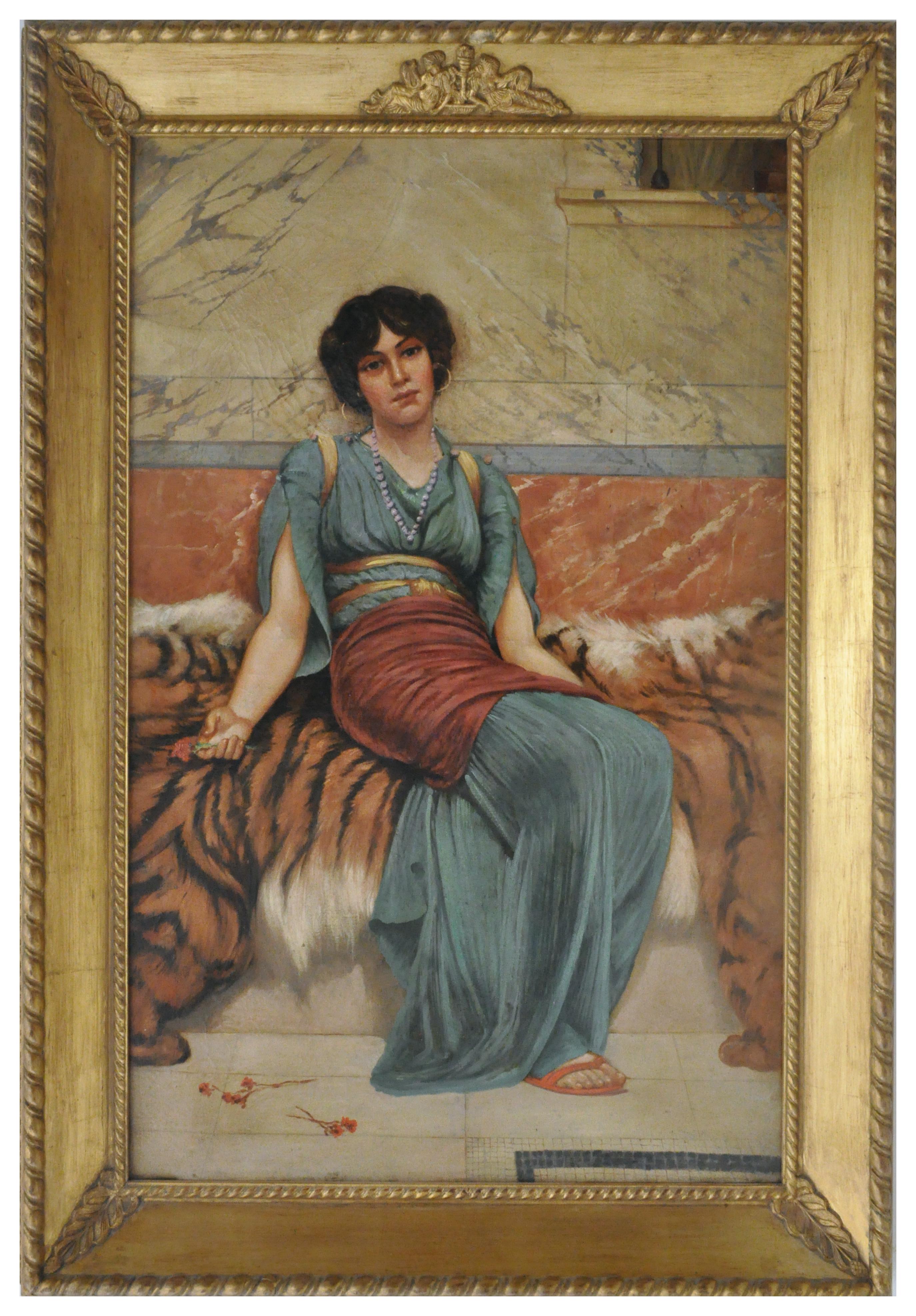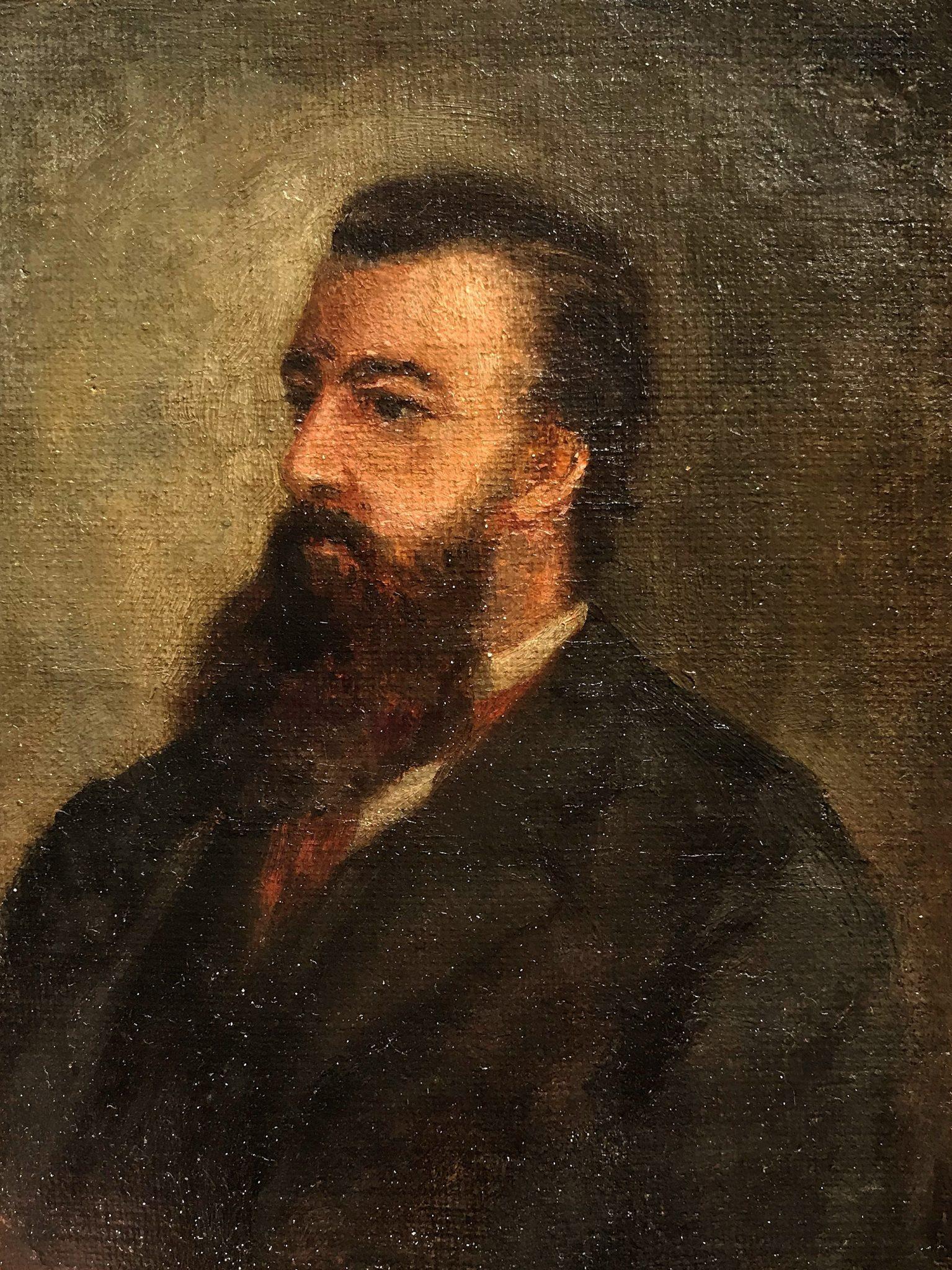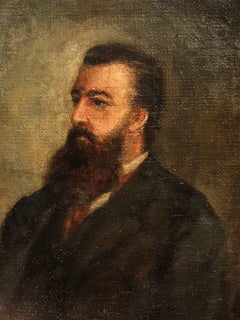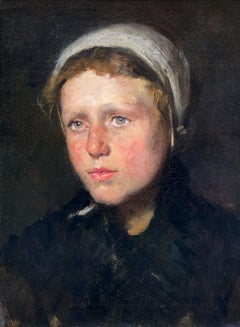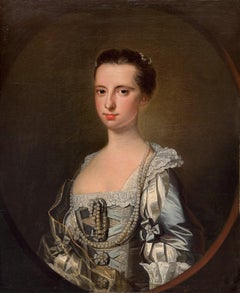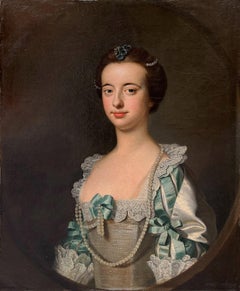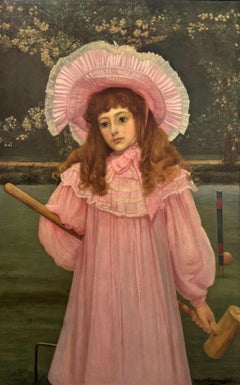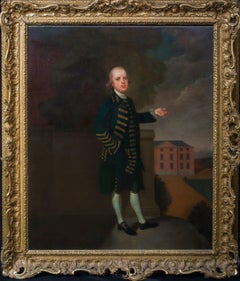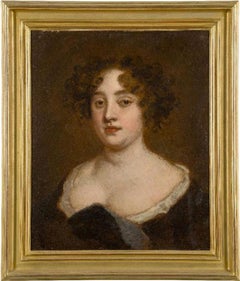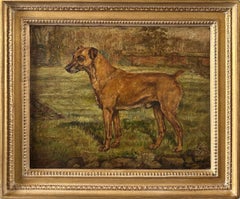Items Similar to Self Portrait, 20th Century Female Artist Oil Painting
Want more images or videos?
Request additional images or videos from the seller
1 of 5
Joan Fairfax Whiteside ARRC FMAASelf Portrait, 20th Century Female Artist Oil Painting
About the Item
Oil on canvas
Image size: 17 3/4 x 13 inches (45 x 33 cm)
Contemporary hand made frame and oval mount
The Artist
Joan Fairfax Whiteside was a prodigious artist and illustrator. Born into an eminent Guernsey family, Joan Fairfax Whiteside was raised in a loving, but occasionally prohibitive, traditional home. Her youthful ambitions of becoming an actress or musician were discouraged by her father as unsuitable occupations. Fortunately, her hopes for an artistic career proved more successful – aided by a kindly uncle who offered to fund her tuition.
Exhibiting at The Royal Academy and Royal Society of Portrait Painters while also working as an illustrator, Fairfax Whiteside was both credible artist and commercial success. Her work so impressed one newspaper art editor that he was determined to raise her profile when he later became an art agent. With the advent of World War II, however, Fairfax Whiteside’s skills were destined for a more scientific end.
Fairfax Whiteside studied at Heatherley’s School of Fine Art in Chelsea, London. Founded in 1845, it was the first art school to admit women on equal terms with men. After graduating, she made great strides as an artist and illustrator, despite popular prejudice against women in the profession. Indeed, on her agent’s advice, Fairfax Whiteside judiciously signed her paintings ’J’ to conceal her gender.
In 1945, Fairfax Whiteside joined the Royal Air Force as a Voluntary Aid Detachment of the Red Cross. Posted to the RAF Hospital at Halton, she nursed injured airmen and turned her hand to medical illustration – documenting reconstructive surgery in forensic detail. She worked in this capacity throughout the war, for which she was awarded the Royal Red Cross Medal and a visit to Buckingham Palace to meet George VI. Later, she also became a founding member of the Medical Artists’ Association.
- Creator:Joan Fairfax Whiteside ARRC FMAA (1904 - 2001, British)
- Dimensions:Height: 17.75 in (45.09 cm)Width: 13 in (33.02 cm)
- More Editions & Sizes:1 of 1 Price: $1,626
- Medium:
- Movement & Style:
- Period:
- Condition:
- Gallery Location:London, GB
- Reference Number:1stDibs: LU52412639572
About the Seller
5.0
Vetted Professional Seller
Every seller passes strict standards for authenticity and reliability
Established in 2007
1stDibs seller since 2014
80 sales on 1stDibs
Typical response time: 3 hours
- ShippingRetrieving quote...Shipping from: London, United Kingdom
- Return Policy
Authenticity Guarantee
In the unlikely event there’s an issue with an item’s authenticity, contact us within 1 year for a full refund. DetailsMoney-Back Guarantee
If your item is not as described, is damaged in transit, or does not arrive, contact us within 7 days for a full refund. Details24-Hour Cancellation
You have a 24-hour grace period in which to reconsider your purchase, with no questions asked.Vetted Professional Sellers
Our world-class sellers must adhere to strict standards for service and quality, maintaining the integrity of our listings.Price-Match Guarantee
If you find that a seller listed the same item for a lower price elsewhere, we’ll match it.Trusted Global Delivery
Our best-in-class carrier network provides specialized shipping options worldwide, including custom delivery.More From This Seller
View AllPortrait of Thomas Cooper Gotch, 19th Century Oil Painting
Located in London, GB
Oil on canvas on board
Image size: 7 x 5¼ inches (18 x 13.5 cm)
Framed
This portrait of Thomas Gotch is by his lifelong friend and confidante, Jane Ross, whom he met at Heatherley’s...
Category
1880s English School Portrait Paintings
Materials
Canvas, Oil
Portrait of a Peasant Girl, 19th Century English Oil Painting
Located in London, GB
Oil on canvas
Image size: 15 1/2 x 11 1/4 inches (39.5 x 28.75 cm)
Original gilt frame
This is a touching head and shoulders portrait of a young peasant girl. Wearing a headscarf, a...
Category
19th Century English School Portrait Paintings
Materials
Canvas, Oil
Portrait of Lady Mansfield of Ringwood
By Thomas Hudson
Located in London, GB
Portrait of Lady Mansfield of Ringwood
Oil on Canvas
Image size: 25 x 30 inches (63 x 76 cm)
Original carved & gilded frame
POA
Provenance
Descended through the Family Estate
The y...
Category
18th Century English School Paintings
Materials
Canvas, Oil
Portrait of Lady Mansfield of Ringwood
By Thomas Hudson
Located in London, GB
Portrait of Lady Mansfield of Ringwood
Oil on Canvas
Image size: 25 x 30 inches (63 x 76 cm)
Original carved & gilded frame
POA
Provenance
Descended through the Family Estate
Born in Poland in 1760 to the 2nd Earl of Mansfield and his wife, Elizabeth Mary Murray would later come under the care of her uncle, William Murray (1st Earl of Mansfield) at Kenwood House in Hampstead. David Murray (2nd Earl of Mansfield) was set to inherit the title and full wealth of his uncle, including Kenwood House. Lady Mansfield’s second cousin would soon join her at Kenwood, where they would be raised together and featured in multiple portraits of the time. Her younger sister, Henrietta, is seen in a separate portrait done by Thomas Hudson as well. At the age of 25 she married George Finch-Hatton, an English aristocrat and politician who sat in the House of Commons from 1772-1784.
Gazing out at the viewer, Lady Mansfield wears a decorated dress, with an abundance of pearls and lace, and a transparent gold lined veil surrounding her right shoulder. The excess of luxurious fabric matches another Hudson portrait of another Lady Mansfield, with the lace detailing and complementary bodice. The depiction of this Lady Mansfield epitomizes the style of portraiture in the 18th century, such as the styles Hudson’s pupils Joshua Reynolds, Joseph Wright, and Peter Toms. From Hudson’s travels to the Low Countries and Italy, he no doubt brought back artistic inspiration from the international pieces he encountered.
Thomas Hudson
Hudson was a celebrated 18th century portrait painter. Born in Devon in 1701 he studied under the artist Jonathan Richardson and married his daughter, against Richardson’s wishes.
He had many artistic friends including William Hogarth and Francis Hayman and travelled with them in Europe in 1748. He also visited Italy with the sculptor Louis-François Roubiliac in 1752. Hudson’s style of portraiture proved so successful that for a decade from 1745 to 1755 he was London’s most popular portrait painter and made a fortune painting the cream of London society and members of the Royal Family.
He was also a talented teacher, perhaps too good, as subsequently a number of his former assistants overtook him in popularity including the artist Joshua Reynolds.
Hudson retired in the late 1750’s and died in Twickenham in 1779. His most notable works include portraits of King George II and George Friedrich Handel and his “Portrait of a Nobleman in Van Dyck dress.” Many of Hudson’s works may be seen in art galleries. These include the National Portrait Gallery, the National Maritime Museum, the Tate Gallery, the Foundling Museum and the Bristol City Museum and Art Gallery. His works are also in Museums across the world...
Category
18th Century English School Paintings
Materials
Canvas, Oil
Portrait of Oliver Cromwell (1599-1658), bust-length, in armour
By Robert Walker
Located in London, GB
After Robert Walker
1599 - 1658
Portrait of Oliver Cromwell (1599-1658), bust-length, in armour
Oil on canvas
Image size: 24 x 29 inches (61 x 73 cm)
Original carved gilt frame
This...
Category
17th Century English School Portrait Paintings
Materials
Canvas, Oil
Price Upon Request
Sailor Smoking a Pipe
By Arthur David McCormick
Located in London, GB
Sailor Smoking a Pipe
Arthur David McCormick
Oil on canvas
Image size: 19 x 25 1/2 inches (48 x 65 cm)
Contemporary frame
Arthur David McCormick (1860–1943) was a notable British illustrator and painter, renowned for his landscapes, historical scenes, naval subjects, and genre scenes. Born in Coleraine, County Londonderry, he pursued his education at the Royal College of Art in London from 1883 to 1886.
McCormick’s career was marked by his contributions to various illustrated magazines, including the English Illustrated Magazine and the Illustrated London News. He participated in significant expeditions, such as Sir Martin Conway’s journey to the Karakoram Himalayas in 1892 and Clinton T. Dent’s expedition to the Caucasus Mountains in 1895. His illustrations from these travels were featured in Conway’s book “Climbing and Exploration in the Karakoram-Himalayas” (1894) and his own publication “An Artist in the Himalayas” (1895).
Throughout his career, McCormick illustrated nearly thirty books, focusing on travel and adventure themes. Some of his notable works include illustrations for Edgar Allan Poe’s “Tales of Mystery and Imagination” (1905) and Henry Newbolt’s “Drake’s Drum and Other Songs of the Sea” (1914). He was also a regular exhibitor at the Royal Academy from 1889 to 1938.
Navy Cut Sailor Work...
Category
20th Century English School Portrait Paintings
Materials
Canvas, Oil
You May Also Like
"Anyone for Croquet" Herbert Gustave Schmalz, Portrait by Pre-Raphaelite Artist
Located in New York, NY
Herbert Gustave Schmalz
Anyone for Croquet, circa 1898
Signed lower right
Oil on canvas
47 5/8 x 31 3/4 inches
Provenance
Anthony Mitchell, Nottingham
Burlington Gallery Ltd., Londo...
Category
1890s English School Figurative Paintings
Materials
Canvas, Oil
Portrait Of A Gentleman & His Estate, Attributed to Arthur Devis, 18th Century
By Arthur Devis
Located in Blackwater, GB
Portrait Of A Gentleman & His Estate, 18th Century
attributed to Arthur DEVIS (1712-1787)
One of a matching pair - the other is believed to be the brother
Large 18th century Eng...
Category
18th Century English School Portrait Paintings
Materials
Canvas, Oil
Studio Of Sir Peter Lely - Portrait Of Lady Francklin Of Bedfordshire
By Sir Peter Lely
Located in Blackwater, GB
Portrait Of Lady Francklin of Bedfordshire, 17th Century
Studio of Sir Peter Lely (1618-1680)
Fine 17th Century English portrait of Lady Fr...
Category
17th Century English School Portrait Paintings
Materials
Canvas, Oil
A portrait of an English terrier dog standing in a walled garden, signed.l
By John Emms
Located in Bath, Somerset
A terrier named Joe standing in an English country house walled garden, painted by the eminent animal painter John Emms (1844-1912) in the late 19th cent...
Category
1890s English School Animal Paintings
Materials
Oil, Canvas
NEOCLASSICAL FIGURE -In theManner of J. W. Godward Italy Oil on canvas painting
By Eugenio De Blasi
Located in Napoli, IT
Sweet Dreams - Oil on canvas painting, Eugenio De Blasi, Italy, 2011
Gold leaf gilded wooden frame cm. 134x94
The painting by Eugenio De Blasi is inspired by the painting "Sweet Dreams" by John William Godward, a neoclassical Victorian painter...
Category
2010s English School Figurative Paintings
Materials
Canvas, Oil
George Clint ARA (Attributed), Portrait Of A Lady In A Brown Dress
Located in Cheltenham, GB
This early 19th-century half-length portrait attributed to British artist George Clint ARA (1770-1854) depicts a young lady wearing a beautiful brown dress, bonnet decorated with small flowers, gold earrings and coral necklace. Clint was a distinguished painter and mezzotint engraver predominantly known for portraiture and dramatic scenes.
Set before an evocative classically-inspired backdrop, she looks out from across the centuries with a composed demeanour. Adorned in the latest fashions, oversized ‘gigot’ sleeves, a delicately-poised bonnet, and a coral necklace for good luck. It’s a charming portrayal by a masterful hand.
Born at Drury Lane, in the heart of London’s West End, George Clint was destined to lead an exuberant life amid the spectacle of theatreland. His father, Michael Clint, was a hairdresser during a time of “hair pomatum, whalebone, wire, lace gauze, and feathers” - so young George would have encountered a variety of ‘characters’ during his childhood.
But despite these elevated surroundings, he soon discovered the darker side of London when thrust into the world of employment. Apprenticed initially as a fishmonger, he trained under a ferocious master who was known to beat him. The hours were unsocial, the conditions rank, and the work was brutal. He soon quit but subsequently found himself toiling for a corrupt attorney who demanded he undertake unscrupulous acts on his behalf.
Seeking a less volatile role, he turned next to house painting, at which he excelled. Commissioned, among other projects, to paint the stones of the arches in the nave of Westminster Abbey. Aside from an incident whereby he almost fell from the second story of a building, all was going well.
Following his marriage in 1792 to Sarah Coxhead, a farmer’s daughter, he began work in earnest as a painter of miniatures, determined to forge a career. Robert William Buss’ memoir celebrates Clint’s success as a miniaturist, stating that “great manual excellence was united with that chaste, delicate feeling for female beauty which characterised all Mr. Clint's portraits of ladies.”
Until this point, it appears he was predominantly self-taught, presumably constrained by a lack of finances. But from hereon in, his industrious nature coupled with several fortunate encounters, led to him developing an enviable talent for both painting and engraving. During the early 19th-century, the acquaintances one kept could make or break your fortunes and perhaps acutely aware of this, Clint’s ‘society’ was an ever-evolving circle of influential personalities.
He was “initiated into the mysteries of engraving” by Edward Bell (act.1794-1819) and produced numerous works after the foremost artists, such as George Stubbs, John Hoppner, and Thomas Lawrence. Following a commission from Lawrence, he struck up a long-term friendship.
Admired for his skill as a mezzotint engraver, he sought next to hone his technique in oils and, as with many aspiring portraitists, his first work in this respect was a depiction of his beloved wife. The pair were both delighted with it, yet over time Clint began to doubt himself and sought the validation of a superior hand - that of Sir William Beechey (1753-1839). However, paralysed with insecurity, he couldn’t face the potential criticism, so his wife took it instead - “with a child under one arm and the portrait in the other”. The result was immeasurably more positive than he’d envisaged and he became closely associated with Beechey until his death in 1839.
Numerous commissions followed from the landed gentry including Lord Egremont, Lord Spencer, and Lord Essex. But also from the theatrical community who would fill his studio at 83 Gower Street, Bloomsbury. His connections within the world of acting led to notable works such as ‘Malvolio and Sir Toby’ (from William Shakespeare's 'Twelfth Night', Act II, Scene iii)’ and ‘Harriet Smithson as Miss Dorillon, in Wives as They Were, and Maids as They Are’.
While his efforts in mezzotint included several contributions to JMW Turner’s Liber Studiorum.
As a measure of his success, Clint was elected an Associate of the Royal Academy in 1821 - a position he later relinquished for personal reasons. Today, he’s represented in numerous public collections including at The British Museum, Harvard Art Museums, The Met, V&A, Yale Center for British Art, and the National Portrait Gallery.
“The respect in which he was held, not only by his brother artists, but by an immense number of eminent men in various professions, and others of the highest rank, was the result of a rare combination of talent, candour, suavity of manner, and integrity of purpose”. [Obituary, 1854].
Housed in a period gilt frame, which is probably original.
Learn more about George Clint ARA in our directory.
Labels & Inscriptions: Supplier’s stencil from Rowney & Forster. The National Portrait Gallery holds a database of supplier’s stencils over the decades. The one here is also presented on two other works by George Clint. ‘Falstaff’s Assignation with Mrs Ford...
Category
1830s English School Portrait Paintings
Materials
Canvas, Oil
Recently Viewed
View AllMore Ways To Browse
Red Cross Vintage
English Musicians
Vintage Nurse
Nurse Vintage Art
Maria Stuart
Old Man With Staff Figure
A Hoppner Painting
Abe Lincoln
George Gower
George Knapton
Jonathan Richardson
Joseph Wright Of Derby
Joyce Moore
Oil Painting Of King George V
Oil Portraits Of Handsome Young Man
Pompeo Batoni
Princess Diana Sculpture
Samuel Clarke
